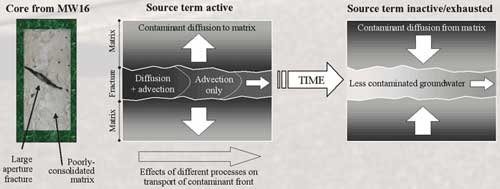
![]()
G P Wealthall, S F Thornton and D N Lerner
Groundwater Protection and Restoration Group,
University of Sheffield, UK
www.sheffield.ac.uk/gprg
The Chalk Aquifer
The Chalk aquifer can be conceptualised as a dual-porosity system, with flow and transport occurring primarily in a pervasive high-transmissivity fracture network, and the bulk of groundwater being stored in the low-transmissivity porous matrix:
- The aquifer consists of 99% calcium carbonate (CaCO3), with occasional marl and flint layers, but very low mineral oxide (MnO2, Fe(OH)3) content
- The aquifer matrix has high porosity (ca. 30-45%) but low effective permeability, and the matrix pore water is essentially immobile
- The matrix is dissected by sets of fractures, which contribute only 1% of the aquifer porosity, but which have very high permeability and dominate groundwater flow
- The primary dilution mechanism is diffusion into the matrix. Reversible contaminant diffusion profiles result from the exchange of contaminants between the fractures and the matrix
- Degradation of pollutants in the matrix, is at present, poorly understood.


